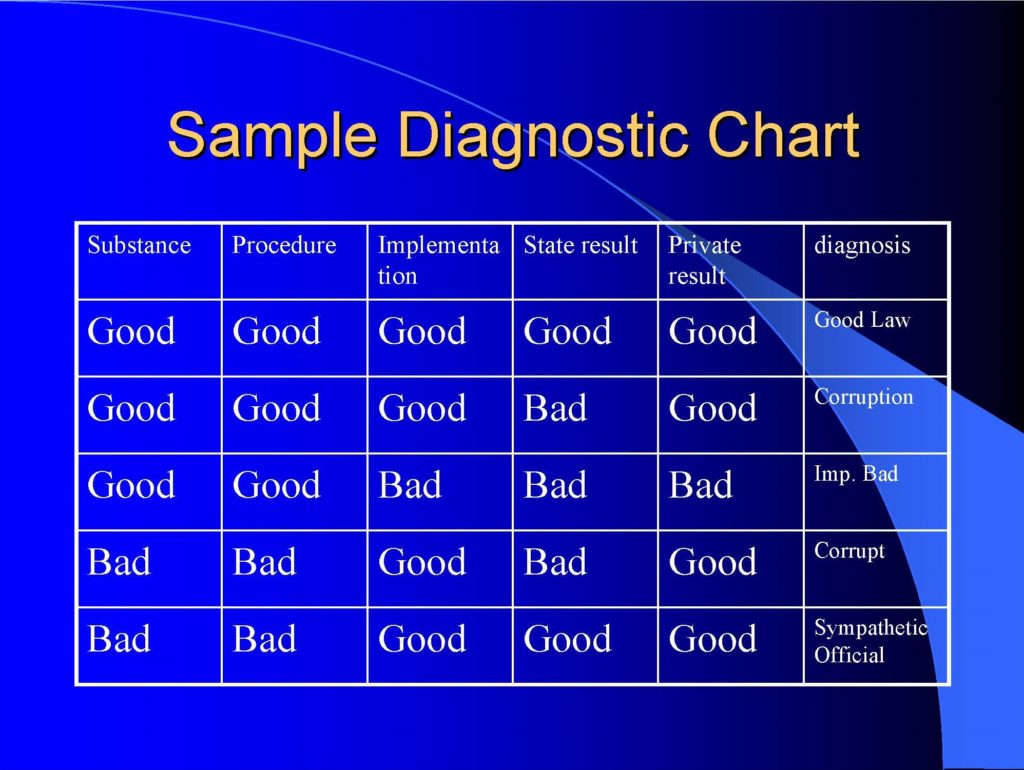Good Governance: Rule of Law
Anti-corruption Strategy
2002
Good Governance 2002 (pdf version)
Legal & Regulatory
- Legal and Regulatory Assessment
- Streamlining
- Civil Society Participation
- E-Governance/Access to Information
Approach
- Goal – Self-Correcting, self-improving system of globally competitive, corruption free governance
- Means – Stakeholder participation necessary for policies and laws that
- meet Armenia’s current and future needs
- stakeholders “own” and will voluntarily comply with
Action Plan
- Action – Provide framework for a process that will produce desired result
- Enable stakeholders to engage in evaluation of current situation
- Clarify policy objectives
- Understand constraints
- Generate options and solutions
- Build consensus for solutions best suited to Armenia’s needs
Not Give, but Find Solutions
- Won’t give solutions, work together to find solutions
- In order to avoid
- Imposed solutions
- Solutions that have not been tested in similar situations
- Solutions at odds with values, attitudes and practice
- Solutions that are too complex, costly, or difficult to understand or implement
- Solutions that have not been debugged, quality tested, abused-proofed
Hypotheses
- Hypotheses
-
- Discussion
- Testing
- Refinement
- Rejection
- Aim to produce new better hypotheses and policies
Hypothesis 1
- For Armenia to prosper, it must be home to globally competitive companies and workers
Hypothesis 2
- For Armenia to be home to globally competitive companies and workers, it must have a globally competitive environment.
Hypothesis 3
- Creating a globally competitive environment requires public-private partnership, but the public sector must take the lead.
Hypothesis 4
- To be globally competitive, the environment must be corruption-free, or corruption must be reduced to a level that makes Armenia at least as attractive on the whole as its competitors.
Hypothesis 5
- To be globally competitive, it must be at least as easy, predictable and cost efficient to live, work and produce in Armenia as in other countries.
Hypothesis 6
- The “rule of law” and legal and regulatory framework are decisive factors for Armenia’s global competitiveness and ultimate prosperity (Barro thesis).
Hypothesis 7
- The global standard for rule of law is “due process” which has two aspects– substantive and procedural.
Substantive Due Process
- Substantive Due Process
- Legal efficiency
- Legitimate state end – Policy Clarification
- Least restrictive means
Procedural Due Process
- Procedural Due Process
- Notice/petition
- Opportunity to be heard
- Reasoned decision-making
- Review/Reconsideration/Appeal
Hypothesis 8
- To the extext corruption in Armenia is “victim-of-circumstances” corruption, it can be corrected or ameliorated by institutional or legal reforms.
Hypothesis 9
- To the extent that Armenia’s corruption is the result of a “culture of corruption,” it will require changes in values, mentalities and attitudes.
- Might makes right
- Money talks
- My friend right or wrong
Hypothesis 10
- When the formal rules of a system do not produce good results, from the point of view of stakeholders, they will circumvent the rules and will create an informal system of rules.
Hypothesis 10a
- When people view the overall system as reasonable, fair and equitably applied, they are likely to exercise self-restraint and voluntarily comply with the laws.
Hypothesis 11
- The propensity to circumvent the law depends upon a number of factors:
- Quality of laws
- Correspondence to stakeholders’ interests
- History, culture, tradition
- Values – relationship vs. rights
- Degree to which people embrace the law as a good that serves their needs and the common good.
- Awareness
- Ease of compliance . . .
Hypothesis 12
- In Armenia, there is an observable gap between the formal (written/enacted) laws and the informal rules. Nevertheless, there is, as in any society, widespread, if often unsuccessful attempts, at voluntary compliance.
Hypothesis 13
- The gaps between written and unwritten rules can be viewed from a number of perspectives:
- Substance
- Procedure
- Implementation
- Results from the state’s perspective
- Results from the private perspective
Substance
- Good policy
- Legitimate state purpose that enjoys a broad consensus
- Fair and equitable
- Good results
Procedure
- Due process
- Fair and equitable, open, transparent
- Not burdensome to implement or comply with
- Least restrictive means to a legitimate state end
- User-friendly, consumer-oriented
Implementation
- Implementation follows written rules
- Rules as applied = rules as designed
Results – State Viewpoint
- The rules regularly achieve the legitimate state interest
- Policy is effectively carried out
Results Private Viewpoint
- Good result for the private stakeholder, taking only personal interest into account
Sample Diagnostic Chart

Hypothesis 14
- Drastic or inflexible penalties more often result in circumvention than deterrence.
Hypothesis 15
- Abuse of discretion and circumvention can result from both under- and over-specificity.
Hypothesis 16
- Much corruption arises from the effort to circumvent a formal system which the stakeholders have determined does not correspond to their actual interests, practices, values and behaviors:
- Willing giver, willing taker
- Resigned giver, entitled taker
- Unwilling giver, coercive taker
- Unwilling giver, coerced taker
Hypothesis 17
- Circumvention is a way of avoiding risk.
- Risk of law-abiding behavior that others will not play by the rules (prisoners’ dilemma)
- Risk of complex, unpredictable rules
- No one wants to be a chump
Hypothesis 18
- Laws and regulations will be better designed, if they must be accompanied by a “legal efficiency report” that
- Clearly states the purpose of the law
- Demonstrates that the law is the least restrictive means to a legitimate state end
- Demonstrates that the law permits all common transactions in a globally competitive way
- Quality control – debugged, abuse-proofed
Hypothesis 19
- Mandatory notice and a meaningful opportunity to be heard will improve the quality of laws and regulations.
Hypothesis 20
- Reasoned decision- and rule-making will improve the quality of laws and create the basis for a self-correcting system of rule-making.
Hypothesis 21
- Publishing of judicial opinions on the internet is a non-intrusive, cost-effective way improve court transparency.
Hypothesis 22
- Review and Reconsideration will improve the quality of laws by providing for correction as a natural and foreseeable part of the rule-making process.
Hypothesis 22
- Anti-corruption is one societal goal among many, and it should be implemented in such a way as to achieve the greatest long-term benefit with the least short- and long-term negative side effects.
Hypothesis 23
- Policy clarification requires a clarification of the role and goals of government in a free market democracy.
Hypothesis 24
- In order for citizens to willing pay for services and comply with rules, government must perform in a fair and competent way certain minimum functions and provide certain public goods and services.
Hypothesis 25
- Satisfaction with public services depends upon a realistic assessment of the budgetary and other constraints on the public sector.
Hypothesis 26
- Within existing constraints, Government should only do what it can do well. First do no harm.
Hypothesis 27
- While a living wage is not sufficient to eliminate the incentive for corruption, it is necessary.
- salary = officially make + unofficially take
Hypothesis 28
- The more government officials there are and the more interactions that are required between officials and private sector, the more the risk of corruption.
- Reducing the size and scope of government can reduce corruption.
Hypothesis 29
- Rules should be no more complex
- than necessary to achieve a legitimate state end
- than the ability of the people and system to understand and administer it
- than the ability of the people and system to pay for them
Hypothesis 30
- Corruption cannot be eliminated without reducing the size of government to the level that society can afford so that its efficiency and salaries are improved.
Hypothesis 31
- Paying civil servants is not sufficient. Honesty and competence, including civil society evaluation of service, need to be criteria for hiring, promoting, firing, and retraining of civil servants.
Hypothesis 32
- Separating (1) policy-making from (2) oversight and (3) implementation functions could reduce corruption.
Hypothesis 33
- Introducing the concept of respondent superior, currently applicable in the private sector, could reduce corruption, that is, superiors are liable for the wrongful actions of subordinates.
- Remove “just taking orders” as a mitigating factor
Hypothesis 34
- Corruption can be reduced by converting informal cash flows into formal systems will by public services into a fee-for-services system –e.g., education, health.
Hypothesis 35
- Corruption can be reduced by subsidizing individuals to purchase necessary services rather than subsidizing institutions to provide free services.



